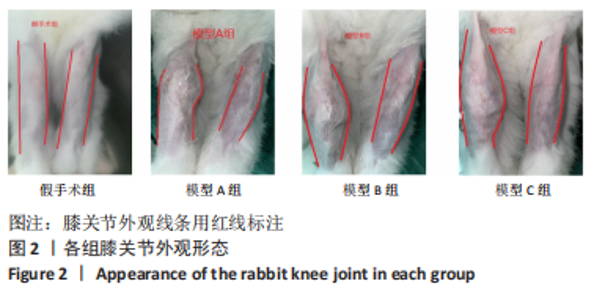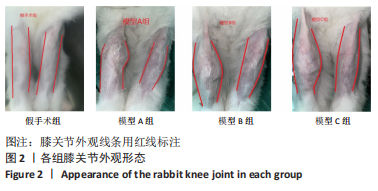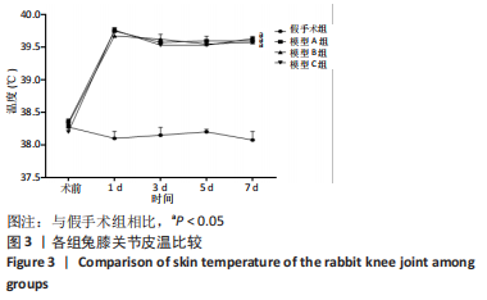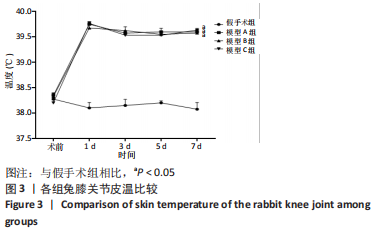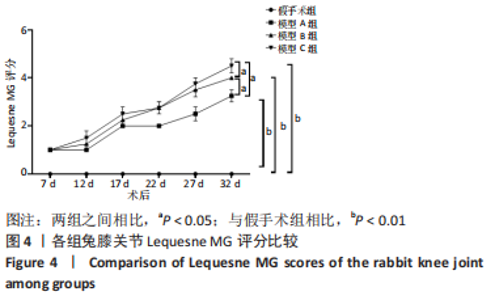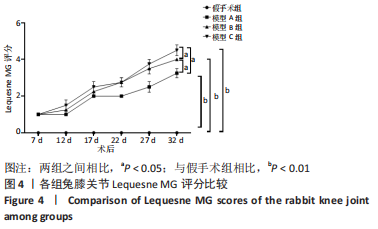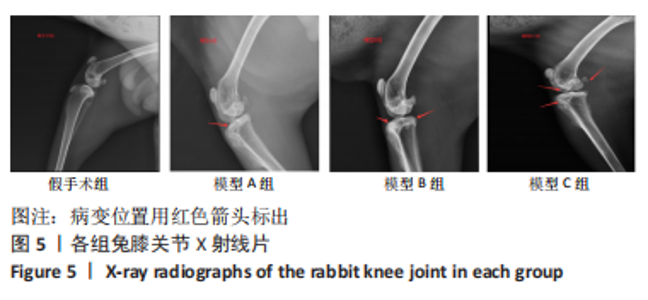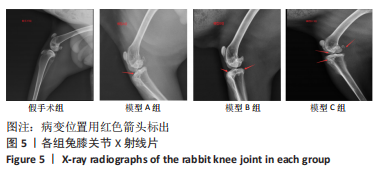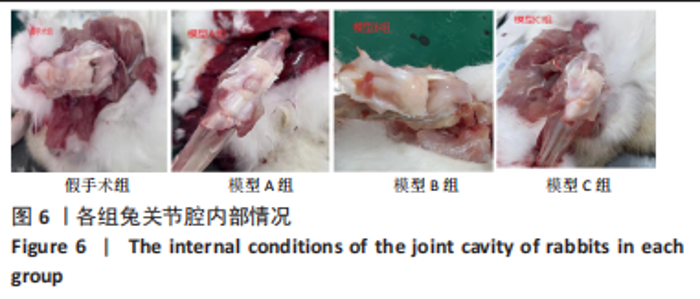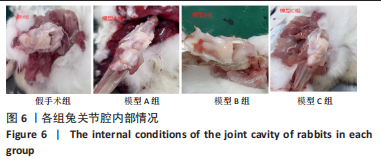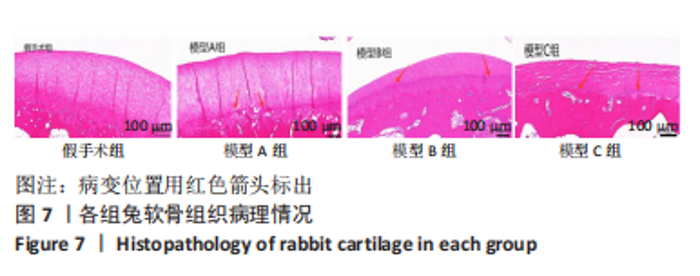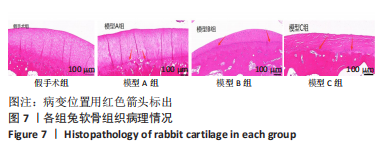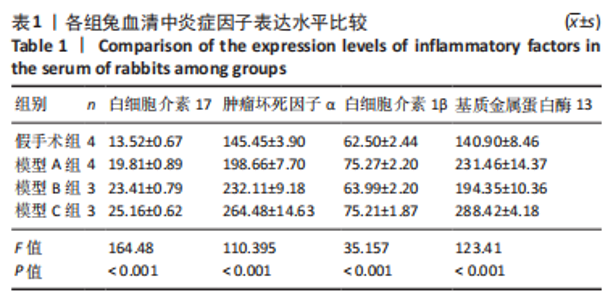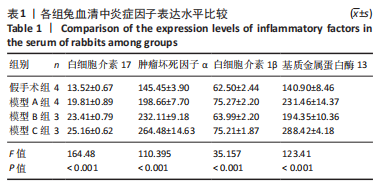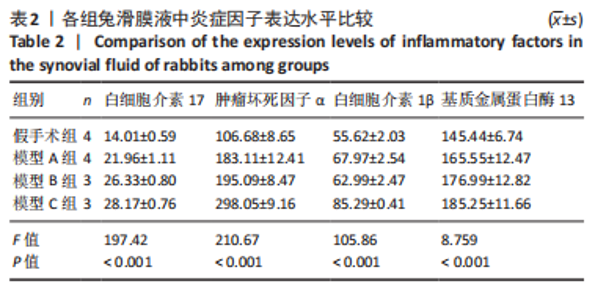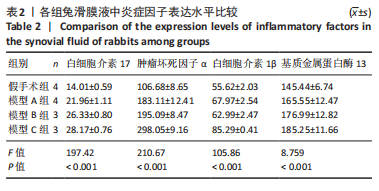Chinese Journal of Tissue Engineering Research ›› 2023, Vol. 27 ›› Issue (23): 3646-3652.doi: 10.12307/2023.579
Previous Articles Next Articles
Preparation of rabbit models of surgically induced knee osteoarthritis
Zhang Chuancheng1, Shen Meihua1, Chen Lifeng2, Wang Huasong2, Xiang Yang1, Tan Zhangkui2
- 1Wuhan University of Science and Technology, Wuhan 430065, Hubei Province, China; 2Central Theater Command General Hospital of the Chinese PLA, Wuhan 430070, Hubei Province, China
-
Received:2022-06-28Accepted:2022-10-24Online:2023-08-18Published:2023-01-16 -
Contact:Chen Lifeng, MD, Associate chief physician, Central Theater Command General Hospital of the Chinese PLA, Wuhan 430070, Hubei Province, China -
About author:Zhang Chuancheng, Master candidate, Wuhan University of Science and Technology, Wuhan 430065, Hubei Province, China Shen Meihua, Master, Wuhan University of Science and Technology, Wuhan 430065, Hubei Province, China -
Supported by:Young Top-notch Medical Talents of Hubei Province (the First Level), No. 1371 (to CLF)
CLC Number:
Cite this article
Zhang Chuancheng, Shen Meihua, Chen Lifeng, Wang Huasong, Xiang Yang, Tan Zhangkui. Preparation of rabbit models of surgically induced knee osteoarthritis[J]. Chinese Journal of Tissue Engineering Research, 2023, 27(23): 3646-3652.
share this article
Add to citation manager EndNote|Reference Manager|ProCite|BibTeX|RefWorks
| [1] KAN HS,CHAN PK,CHIU KY, et al. Non-surgical treatment of knee osteoarthritis. Hong Kong Med J. 2019;25:127-133. [2] 中华医学会骨科分会关节外科学组,吴阶平医学基金会骨科学专家委员会. 膝骨关节炎阶梯治疗专家共识(2018年版)[J]. 中华关节外科杂志(电子版),2019,13(1):124-130. [3] NAJAFI S, SANATI E, KHADEMI M, et al. Intra-articular botulinum toxin type A for treatment of knee osteoarthritis: Clinical trial. Toxicon. 2019; 165:69-77. [4] JIN H, ZUO H, Xu R, et al. A case report of ultrasound-guided knee nerve pulse radiofrequency combined with platelet-rich plasma in the treatment of knee osteoarthritis. Medicine (Baltimore). 2021; 100(51):e27878. [5] GONG J, LI Q, WEI M, et al. Effect of Tongluozhitong Prescription-Assisted Intra-Articular Injection of Sodium Hyaluronate on VAS Score and Knee Lysholm Score in Patients with Knee Osteoarthritis. Evid Based Complement Alternat Med. 2021;2021:3210494. [6] ROEMER FW, GUERMAZI A, ZHANG Y, et al. Hoffa’s Fat Pad: Evaluation on Unenhanced MR Images as a Measure of Patellofemoral Synovitis in Osteoarthritis. AJR Am J Roentgenol. 2009;192(6):1696-700. [7] KLOPPENBURG M, BERENBAUM F. Osteoarthritis year in review 2019: epidemiology and therapy. Osteoarthritis Cartilage. 2020;28(3): 242-248. [8] MCCOY AM. Animal models of osteoarthritis:Comparisons and key considerations. Vet Pathol. 2015;52(5):803-818. [9] DE LANGE-BROKAAR BJ, IOAN-FACSINAY A, YUSUF E, et al. Evolution of synovitis in osteoarthritic knees and its association with clinical features. Osteoarthritis Cartilage. 2016;24:1867-1874. [10] TSAI HC, CHEN TL, CHEN YP, et al. Traumatic osteoarthritis-induced persistent mechanical hyperalgesia in a rat model of anterior cruciate ligament transection plus a medial meniscectomy. J Pain Res. 2018;11: 41-50. [11] BURKE CJ, ALIZAI H, BELTRAN LS, et al. MRI of synovitis and joint fluid. J Magn Reson Imaging. 2019;49:1512-1527. [12] 苏剑清,孙波,丁韵蓉,等.基于“损伤-修复-再损伤”方法制备兔膝骨关节炎滑膜炎模型[J].中国组织工程研究,2022,26(23): 3738-3743. [13] 熊元,赵振国,李传郡,等.兔膝骨关节炎模型的制备及鉴定[J].实验动物科学,2013,30(3):31-34+63. [14] PAS HI, WINTERS M, HAISMA HJ, et al. Stem cell injections in knee osteoarthritis: a systematic review of the literature. Br J Sports Med. 2017;51(15):1125-1133. [15] RODRIGUEZ-MERCHAN EC, DE LA CORTE-RODRIGUEZ H. The role of orthoses in knee osteoarthritis. Hosp Pract(1995). 2019;47:1-5. [16] 曹向昱,刘雨曦,曹永平.老年退行性骨关节炎治疗进展[J].中国临床保健杂志,2022,25(1):25-29. [17] TEICHTAHL AJ, WLUKA AE, WIJETHILAKE P, et al. Wolff’s law in action: a mechanism for early knee osteoarthritis. Arthritis Res Ther. 2015;17: 207. [18] LIU L, ZHAO C, ZHAO S, et al. Evaluation of the effectiveness and safety of icariin in the treatment of knee osteoarthritis: A protocol for a systematic review and meta-analysis. Medicine (Baltimore). 2021;100: e28277. [19] 王欣,罗文,黄文泽,等.单侧膝骨关节炎临床分期与双足足底压力的相关性[J].中国组织工程研究,2021,25(27):4312-4317. [20] YUN SJ, LIM Y, JIN W, et al. Validity of Radiograph-Based Infrapatellar Fat Pad Opacity Grading for Assessing Knee Synovitis: Correlation With Contrast-Enhanced MRI. Am J Roentgenol. 2017;209(6):1321-1330. [21] STEINBRUCK A,WOICZINSKI M,WEBER P, et al. Posterior cruciate ligament balancing in total knee arthroplasty:a numerical study with a dynamic force controlled knee model. Biomed Eng Online. 2014;13:91. [22] HULTH A, LINDBERG L, TELHAG H. Experimental osteoarthritis in rabbits. Acta Orthop Scand. 1970;41:522-530. [23] ZAPATA-LINARES N, EYMARD F, BERENBAUM F, et al. Role of adipose tissues in osteoarthritis. Curr Opin Rheumatol. 2021;33(1):84-93. [24] JARRAYA M,DIAZ LE,ROEMER FW,et al.MRI findings consistent with peripatellar fat pad impingement:how much related to patellofemoral maltracking? Magn Reson Med Sci. 2018;17(3):195-202. [25] BELLUZZI E,STOCCO E,POZZUOLI A,et al. Contribution of infrapatellar fat pad and synovial membrane to knee osteoarthritis pain. Biomed Res Int. 2019;2019:6390182. [26] 陈墅,刘宁,周义钦,等. 髌下脂肪垫在膝骨关节炎发病和进展中的作用[J]. 中华骨科杂志,2018,38(15):953-960. [27] 王勃,李英俊,邱丽莎.比较分析膝骨关节炎患者肌骨超声与X线片的表现特点[J].现代医用影像学,2021,30(12):2307-2309. [28] STUTZ G, KUSTER MS, KLEINSTUK F, et al Arthroscopic management of septic arthritis:stages of infection and results. Knee Surg Sports Traum Arthrosc. 2008;8(5):270-274. [29] 谢平金,柴生颋.膝骨性关节炎X线片观测指标及其应用进展[J].中国中医骨伤科杂志,2017,25(3):72-76. [30] SELLAM J, BERENBAUM F. The role of synovitis in pathophysiology and clinical symptoms of osteoarthritis. Nat Rev Rheumatol. 2010; 6(11):625-635. [31] HAYASHI D, ROEMER FW, KATUR A, et al. Imaging of Synovitis in Osteoarthritis:Current Status and Outlook. Semin Arthritis Rheum. 2011;41(2):116-130. [32] 熊颖,顾武斌.X线、超声及MRI影像诊断膝骨关节炎的价值对比分析[J].影像研究与医学应用,2019,3(6):30-32. [33] MATHIESSEN A, SLATKOWSKY-CHRISTENSEN B, KVIEN TK, et al. Ultrasound-detected inflammation predicts radiographic progression in hand osteoarthritis atier 5 years. Ann Rheum Dis. 2016;75(5):825-830. [34] Hayashi D, Roemer FW, Katur A, et al. Imaging of Synovitis in Osteoarthritis:Current Status and Outlook. Semin Arthritis Rheum. 2010;41(2):116-130. [35] KANDAHARI AM, YANG X, DIGHE AS, et al.Recognition of Immune Response for the Early Diagnosis and Treatment of Osteoarthritis. J Immunol Res. 2015;20(15):1-13. [36] KAPOOR M, MARTEL-PELLETIER J, LAJEUNESSE D, et al. Role of proinflammatory cytokines in the pathophysiology of osteoarthritis. Nat Rev Rheumatol. 2011;7(1):33-42. [37] LIAO CR, WANG SN, ZHU SY, et al. Advanced oxidation protein products increase TNF-α and IL-1β expression in chondrocytes via NADPH oxidase 4 and accelerate cartilage degeneration in osteoarthritis progression. Redox Biol. 2020;28:101306. [38] FEI J, LIANG B, JIANG C, et al. Luteolin inhibits IL-1β-induced inflammation in rat chondrocytes and attenuates osteoarthritis progression in a rat model. Biomed Pharmacother. 2019;109:1586-1592. [39] ZHANG C, ZHU M, WANG H, et al. LOXL2 attenuates osteoarthritis through inactivating Integrin/FAK signaling. Sci Rep. 2021;11(1):17020. [40] HOSSEINZADEH A, KAMRAVA SK, JOGHATAEI MT, et al. Apoptosis signaling pathways in osteoarthritis and possible protective role of melatonin. J Pineal Res. 2016;61(4):411-425. [41] ZHAO Y, LI Y, QU R, et al. Cortistatin binds to TNF-α receptors and protects against osteoarthritis. EBioMedicine. 2019;41:556-570. [42] XU Z, KE T, ZHANG Y, et al. Danshensu inhibits the IL-1β-induced inflammatory response in chondrocytes and osteoarthritis possibly via suppressing NF-κB signaling pathway. Mol Med. 2021;27(1):80. [43] CHENG Y, LI F, ZHANG WS, et al. Silencing BLNK protects against interleukin-1β-induced chondrocyte injury through the NF-κB signaling pathway. Cytokine. 2021;148:155686. [44] OZLER K, AKTAS E, ATAY C, et al.Serum and knee synovial fluid matrix metalloproteinase-13 and tumor necrosis factor-alpha levels in patients with late-stage osteoarthritis. Acta OrthopTraumatol Turc. 2016;50(3): 356-361. |
| [1] | Guo Shuhui, Yang Ye, Jiang Yangyang, Xu Jianwen. Screening and validation of neurogenic bladder miRNA-mRNA regulatory network [J]. Chinese Journal of Tissue Engineering Research, 2023, 27(在线): 1-8. |
| [2] | Sun Kexin, Zeng Jinshi, Li Jia, Jiang Haiyue, Liu Xia. Mechanical stimulation enhances matrix formation of three-dimensional bioprinted cartilage constructs [J]. Chinese Journal of Tissue Engineering Research, 2023, 27(在线): 1-7. |
| [3] | Fang Xingyan, Tian Zhenli, Zhao Zheyi, Wen Ping, Xie Tingting. Effects of sodium arsenite on human umbilical vein endothelial cell injury and sphingosine kinases 1/sphingosine 1-phosphate signaling axis [J]. Chinese Journal of Tissue Engineering Research, 2023, 27(在线): 1-7. |
| [4] | Li Xiaomin, Tian Xiangdong, Tan Yetong, Zhu Guangyu, Wang Rongtian, Wang Jian, Xue Zhipeng, Ma Sheng, Hu Yuanyi, Huang Ye, Ding Tiansong. Changes of lower limb force line and knee function after high tibial osteotomy in osteoporotic medial ventricular knee osteoarthritis [J]. Chinese Journal of Tissue Engineering Research, 2023, 27(9): 1325-1329. |
| [5] | Liang Jiaqi, Liu Hengxu, Yang Jinxin, Yang Yi, Deng Xuhui, Tan Mingjian, Luo Jiong. Health benefit relationship between exercise and intestinal bacteria [J]. Chinese Journal of Tissue Engineering Research, 2023, 27(8): 1292-1299. |
| [6] | Gao Yu, Han Jiahui, Ge Xin. Immunoinflammatory microenvironment after spinal cord ischemia-reperfusion injury [J]. Chinese Journal of Tissue Engineering Research, 2023, 27(8): 1300-1305. |
| [7] | Tang Liang, Li Xiheng, Niu Ruijuan, Li Xinyue, Zou Xinying, Mao Tianjiao, Li Jiang. Naringin regulates the function of RAW264.7 macrophages to affect the osteogenic differentiation of MC-3T3-E1 cells [J]. Chinese Journal of Tissue Engineering Research, 2023, 27(8): 1205-1210. |
| [8] | Huang Linke, Wei Linhua, Jiang Jie, Liu Qian, Chen Weiwei. Effects of estrogen combined with treadmill exercise on bone mass and articular cartilage in ovariectomized mice [J]. Chinese Journal of Tissue Engineering Research, 2023, 27(8): 1166-1171. |
| [9] | Ruan Ling, Wang Guanghua, Wu Rongping, Jin Zhan, Lyu Zhenqing, Zhang Nan, Li Shoubang. Correlation between exercise intensity and lipid metabolism disorder and oxidative stress in a high-diet rat model [J]. Chinese Journal of Tissue Engineering Research, 2023, 27(8): 1149-1155. |
| [10] | Li Cheng, Zheng Guoshuang, Kuai Xiandong, Yu Weiting. Alginate scaffold in articular cartilage repair [J]. Chinese Journal of Tissue Engineering Research, 2023, 27(7): 1080-1088. |
| [11] | Wang Min, Yin Xiushan, Wang Yingxi, Zhang Yan, Zhao Long, Xia Shuyue. Inhalation of bone marrow mesenchymal stem cells-derived exosomes alleviates inflammatory injury in chronic obstructive pulmonary disease [J]. Chinese Journal of Tissue Engineering Research, 2023, 27(6): 827-834. |
| [12] | Li Xiaoyin, Yang Xiaoqing, Chen Shulian, Li Zhengchao, Wang Ziqi, Song Zhen, Zhu Daren, Chen Xuyi. Collagen/silk fibroin scaffold combined with neural stem cells in the treatment of traumatic spinal cord injury [J]. Chinese Journal of Tissue Engineering Research, 2023, 27(6): 890-896. |
| [13] | Huang Guijiang, Ji Yuwei, Zhao Xin, Yang Yi, Zhao Yulan, Wang Peijin, Tang Wei, Jiao Jianlin. Effect and mechanism of different administration routes of placenta-derived mesenchymal stem cells in the treatment of tree shrews with osteoporotic fracture [J]. Chinese Journal of Tissue Engineering Research, 2023, 27(6): 909-914. |
| [14] | Li Zhichao, Tan Guoqing, Su Hui, Xu Zhanwang, Xue Haipeng. Regulatory role of non-coding RNAs as potential therapeutic targets in spinal cord injury [J]. Chinese Journal of Tissue Engineering Research, 2023, 27(5): 758-764. |
| [15] | Song Jian, Zhao Lei, Liu Aishi. Construction and application of myocardial ischemia model in miniature pigs [J]. Chinese Journal of Tissue Engineering Research, 2023, 27(5): 772-778. |
| Viewed | ||||||
|
Full text |
|
|||||
|
Abstract |
|
|||||
